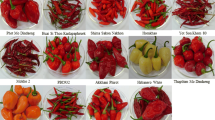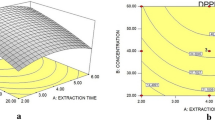Abstract
The accumulation of agricultural waste is representing one of the major and permanent environmental problems because of the large amount of waste poses from one hand and continuation poses of these wastes to environment year-around on the other hand. The current study aims to use the high biomass of guava (leaves and seeds) and pomegranate (peels and seeds) wastes as source of antioxidant compounds. The method focused on extraction of antioxidant compounds from these wastes using different successive extracts: pet.ether, ethyl acetate, acetone, ethanol, and methanol against four different antioxidant determination methods: two radical methods (2, 2 diphenyl-1-picrylhydrazyl (DPPH) and 2, 2′-azino-bis ethylbenzthiazoline-6-sulfonic acid (ABTS.+)) and two non-radical methods (KMnO4 and methylene blue) as new methods for evaluation of antioxidant activity. The results show that the highest antioxidant activities were recorded with DPPH and ABTS radical assay more than KMnO4 and methylene blue. The crude petroleum ether extract of guava seeds showed the highest antioxidant activity with 75.6, 78.4, 19.1, and 15.6% against ABTS, DPPH, KMnO4, and methylene blue respectively, at 100 μg/ml when compared with other extracts and natural antioxidant standard (ascorbic acid). Also, there is great correlation between antioxidant activity against ABTS and DPPH and phenolic compound concentration; also, the thermal stability of antioxidant compounds of promising extract (ethyl acetate of pomegranate seeds) is crucial and may be correlated with both the extraction method and extract content; FTIR was used for interpretation of active groups in both extracts (before and after thermal treatment).




Similar content being viewed by others
References
Aboul-Enein AM, Abu El-Ela F, Shalaby EA, El-Shemy HA (2012) Traditional medicinal plants research in Egypt: studies of antioxidant and anticancer activities. J Med Plants Res 6(5):689–703
Queirós CSGP, Cardoso S, Lourenço A, Ferreira J, Miranda I, Lourenço MJV, Pereira H (2020) Characterization of walnut, almond, and pine nut shells regarding chemical composition and extract composition. Biomass Conv Bioref 10:175–188. https://doi.org/10.1007/s13399-019-00424-2
Beretta G, Rossoni G, Alfredo Santagati N, Maffei Facino R (2009) Anti-ischemic activity and endothelium-dependent vasorelaxant effect of hydrolysable tannins from the leaves of Rhus coriaria (Sumac) in isolated rabbit heart and thoracic aorta. Planta Med 75(14):1482–1488
Saeed S, Bibi I, Mehmood T, Bilal M (2020) Valorization of locally available waste plant leaves for production of tannase and gallic acid by solid-state fermentation. Biomass Convers Bioref. https://doi.org/10.1007/s13399-020-00989-3
Oreopoulou V, Tzia C (2007) Utilization of plant by-products for the recovery of proteins, dietary fibers, antioxidants, and colorants. In: Oreopoulou V, Russ W (eds) Utilization of By-Products and Treatment of Waste in the Food Industry, vol 3. Springer US, United States, pp 209–232
Ardekani MRS, Hajimahmoodi M, Oveisi MZ, Sadeghi N, Jannat B, Ranjbar A, Gholam N, Moridi T (2011) Comparative antioxidant activity and total flavonoid content of Persian pomegranate (Punica granatum L.) cultivars. Iran J Pharm Res 10(3):519–524
Karou D, Dicko MH, Simpore J, Traore AS (2005) Antioxidant and antibacterial activities of polyphenols from ethnomedicinal plants of Burkina Faso. Afr J Biotechnol 4:823–828
Madhusha C, Munaweera I, Karunaratne V, Kottegoda N (2020) Facile mechanochemical approach to synthesizing edible food preservation coatings based on alginate/ascorbic acid-layered double hydroxide bio-nanohybrids. J Agric Food Chem 68(33):8962–8975
Shalaby EA, Shanab SMM (2013) Antioxidant compounds, assays of determination and mode of action. Afr J Pharm Pharmacol 7:528–539
Rossenthaler, L. (1930). The chemical investigation of plants. Translated into English by Sudhamoy Ghosh from the Third German edition. Bell and Sons. Ltd London
Berieskern CH, Klinger-Handpolonius W (1961) Triterpene and sterol in leaves of Saliva trilopa and Pyrus malus. Arch Pharm 294:380–391
Wall ME, Kreider MM, Kremson CF, Eddy CR, Williaman JJ, Coree DS, Gentry HS (1954) Steroidal saponins: survey of plants for steroidal of sapogenins and other constituents. J Pharm Soc 43:1–3
Claus ER (1967) Pharmacognosy, 5th edn. Herny Kimpton, Co. Inc., London
Harper HA (1975) Review of physiological chemistry, 15th edn. Long Medicinal publication, Los Anglos
Meda A, Lamien CE, Romito M, Millogo J, Nacoulma OG (2005) Determination of the total phenolic, flavonoid and praline contents in Burkina Fasan honey, as well as their radical scavenging activity. Food Chem 91:571–577
Yen GC, Chen HY (1995) Antioxidant activity of various tea extracts in relation to their antimutagenecity. J Agric Food Chem 43:27–37
Re R, Pellegrini N, Proteggente A, Pannala A, Yang M, Rice-Evans C (1999) Antioxidant activity applying improved ABTS radical cation decolorization assay. Free Radic Biol Med 26:1231–1237
El-fayoumy EA, Shanab SMM, Gaballa HS et al (2021) Evaluation of antioxidant and anticancer activity of crude extract and different fractions of Chlorella vulgaris axenic culture grown under various concentrations of copper ions. BMC Complement Med Ther 21:51. https://doi.org/10.1186/s12906-020-03194-x
Rumbaoa RGO, Cornago DF, Geronimo IM (2009) Phenolic content and antioxidant capacity of Philippine sweet potato (Ipomoea batatas) varieties. Food Chemistry 113:1133–1138
Shalaby EA, Shanab SMM (2013b) Comparison of DPPH and ABTS assays for determining antioxidant potential of water and methanol extracts of spirulina platensis. Indian J Geo-Mar Sci 42:556–564
Awika JM, Rooney LW, Ronald XW, Prior L, Cisneros-Zevallos L (2003) Screening methods to measure antioxidant activity of sorghum (sorghum bicolor) and sorghum products. J Agric Food Chem 51(23):6657–6662. https://doi.org/10.1021/jf034790i
Aboul-Enein AM, Shanab SM, Shalaby EA, Zahran MM, Lightfoot DA, el-Shemy HA (2014) Cytotoxic and antioxidant properties of active principals isolated from water hyacinth against four cancer cells lines. BMC Complement Altern Med 14:397. https://doi.org/10.1186/1472-6882-14-397
Fatahala SS, Shalaby EA, Kassab SE, Mohamed MS (2015) A promising anti-cancer and anti-oxidant agents based on the pyrrole and fused pyrrole: synthesis, docking studies and biological evaluation. Anti Cancer Agents Med Chem 15(4):517–526
Pękal AJ, Pyrzynska K (2015) Effect of pH and metal ions on DPPH radical scavenging activity of tea. Int J Food Sci Nutr 66(1):1–5
Michalak A (2006) Phenolic compounds and their antioxidant activity in plants growing under heavy metal stress. Pol J Environ Stud 15:523–553
Volf I, Ignat L, Neamtu M, Popa VI (2014) Thermal stability, antioxidant activity, and photo-oxidation of natural polyphenols. Chem Pap 68(1):121–129
Fischer UA, Carle R, Kammerer DR (2013) Thermal stability of anthocyanins and colourless phenolics in pomegranate (Punica granatum L.) juices and model solutions. Food Chem 138:1800–1809. https://doi.org/10.1016/j.foodchem.2012.10.072
Shalaby EA, Mahmoud GI, Shanab SMM (2016) Suggested mechanism for the effect of sweeteners on radical scavenging activity of phenolic compounds in black and green tea. Front Life Sci 9(4):241–225
Author information
Authors and Affiliations
Corresponding author
Ethics declarations
Competing interests
The authors declare no competing interests.
Additional information
Publisher’s Note
Springer Nature remains neutral with regard to jurisdictional claims in published maps and institutional affiliations.
Rights and permissions
About this article
Cite this article
Gaber, N.B., El-Dahy, S.I. & Shalaby, E.A. Comparison of ABTS, DPPH, permanganate, and methylene blue assays for determining antioxidant potential of successive extracts from pomegranate and guava residues. Biomass Conv. Bioref. 13, 4011–4020 (2023). https://doi.org/10.1007/s13399-021-01386-0
Received:
Revised:
Accepted:
Published:
Issue Date:
DOI: https://doi.org/10.1007/s13399-021-01386-0




